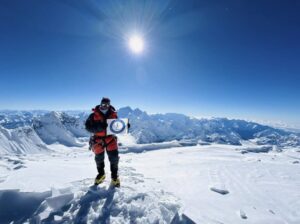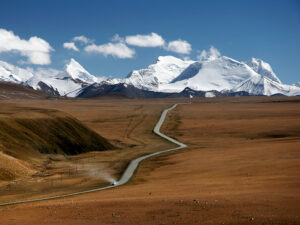Kristin Harila of Norway set foot on top of Cho Oyu on May 3 at 14:45 China time. Her home team highlighted that Cho Oyu is the second summit, after Shishapangma, in her current race to climb all of the world’s 8,000’ers in less than six months.
It’s an odd claim, since with Cho Oyu, Harila has already completed the 14×8,000’ers in record time. She bagged the other 12 summits in 2022. (Previously, she had climbed Everest and Lhotse in 2021. This makes 16 peaks in total on her resumé.)

Kristin Harila’s Instagram story, posted right after she summited Cho Oyu.
Moreover, she has made sure that she has reached — and properly documented — all the true summits, per the geographical studies done by 8000ers.com. Under such criteria, her achievement is even larger.
The fastest “true” 14×8,000’ers
Harila missed becoming the first woman to reach the actual summits of all the 8,000’ers by just a week, according to 8000ers.com’s updated lists. Last week, Dong Hong Juan of China became the first when she summited Shishapangma.
Harila is also the fastest climber, male or female, to achieve the feat. Although Nirmal Purja claims to have set the record in six months and six days in 2019, the 8000ers.com team notes that Purja only summited Manaslu and Dhaulagiri in 2021. The first time around, during that six-month stint in 2019, he stopped at a foresummit on Manaslu and at a lower point on Dhaulagiri’s summit ridge.

Nirmal Purja: Photo @Pemba Sherpa/Red Bull
Since Harila is clearly after breaking records, it is noticeable that instead of highlighting her current accomplishment, Harila has opted to avoid all controversy and try to beat Purja’s record as he originally (if incorrectly) claimed it. That is why, when she was unable to go to Tibet last fall, she made plans to start all over again.
What happened to the no-O2 project?
And so she has. Harila started on Shishapangma on April 26 and will try to finish in less than the 189 days that Purja needed to complete his initial “Project Possible,” from April 23 to October 29, 2019.
In the process, it seems that Harila has dropped some of the improvements she had eyed for this second round. Before snagging permission to climb in Tibet, Harila said she would try to climb all 14 peaks in 2023 without oxygen. She even planned to summit Shishapangma and Cho Oyu twice in order to complete both projects.
Now she seems to have abandoned this idea. She used supplementary oxygen on both Shishapangma and Cho Oyu. It is unlikely that she will now waste even a few days attempting those peaks again without oxygen. She has still seven 8,000’ers to summit in Nepal — six if she leaves Manaslu for the fall — before the monsoon comes at the end of the month.
The slow, snowy spring led to significant delays on Manaslu, which she eventually abandoned for Tibet. Those delays may have forced her hand.

File image of Kristin Harila. Photo: Kristin Harila/Instagram
As on her 2022 climbs, her peak bagging requires an excellent logistics and support team, a powerful budget, determination, enormous physical and mental strength, and a good deal of good luck with the weather and conditions.
As a personal challenge, it is bold, fun, and exciting to try to best Purja’s previous record. And that’s it. Trying to compare either Harila or Purja’s feats to previous milestones in mountaineering not only shows a very incomplete picture but also an unfair one.
The new “firsts” are different
Today, the means of reaching the summit have changed and the spirit of adventure that animated those who first climbed the 14 8,000’ers is over. It ended with the industrialization of mountaineering, the helicopters, the numerous support staff, the high-altitude rescue options, and the vastly improved logistics.
All these advances have made it so much easier to reach the summit that it has all but killed the uncertainty that is the essence of adventure. It is as if someone set off today to travel around the world in 79 days in order to beat Phineas Fogg’s record.

Gerlinde Kaltenbrunner on K2 in 2009. Photo: David Goettler
So while geographically similar — a summit is a summit, and each mountain has only one highest point — there is no pioneering spirit among those who summit 8,000m peaks in 2023. Dong, Harila, and future 14×8,000m summiters may break speed, age, and national records, but these have little to do with the quests of Messner or Kaltenbrunner.
This change did not come suddenly. Contemporary methods and strategies evolved gradually. Edurne Pasaban did not climb as Wanda Rutkiewicz had done. Equally, Kristin Harila is open and honest about how she climbs, and her project is perfectly legitimate. But how and why how and why climbers target these showcase mountains has changed. The age of high-altitude trailblazers has ended. Welcome to the age of the gamers.

Left to right, Kristin Harila, Sophie Lavaud and Viridiana Alvarez on the summit of Shishapangma, April 26, 2023. Photo: Matias Myklebust






